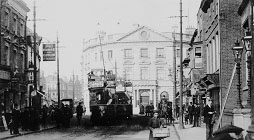Twickenham - Then and Now
A 17th and 18th century fashionable resort, gradually developed into a modern suburb.


Twickenham was established as a Local Board in 1868 and became an Urban District Council in 1895. From the 1850s there was increasing pressure to develop the old estates and these were gradually sold for housing. Market gardening continued to expand in acreage up to the 1870s, mainly to the north of the town. After 1870 the industry began to contract, giving way to urban development.
The 1871 Census offers a glimpse of the type of employment in Twickenham. For women this was mainly domestic service which included cooks, charwomen, laundresses, and kitchen, scullery, parlour and ladies' maids. Altogether these accounted for 80% of female employment. A further 10% were dressmakers, and around 5% were shop workers with the remainder mainly teachers, governesses and nurses. This range of work would only gradually change over time and it was not until the First World War that women were called upon to do work that had not been available to them before.

Male employment in Twickenham in 1871 was more varied. Shop workers, public service and professionals, manufacture, agriculture and also building each accounted for around 15%. The remaining jobs for men were mainly in general labouring, transport and domestic service. Overall this was a time (long before refrigeration) when food shopping was carried out every day, where market gardening was still important locally and where manual labour was still relatively cheap. Woodworking (in the days before plastics) was still important for many items for the home and there were horses rather than cars on the roads.
The increase in population caused by the railways led, in due course, to the creation of tramways, and trams arrived in Twickenham in 1903. Working conditions on the trams were strict and pay was 6/- (30p) a day for a 63 hour, six day week. The large tram depot at Fulwell covered over 5½ acres and was a major local employer

Working life was hard, but the range of leisure activities gradually increased. The river, a working highway, had long been popular with the leisured classes. The Eel Pie Island Hotel, built in 1830 became a resort for picnic parties, visited by pleasure steamers. The Twickenham Rowing Club, formed in 1860 soon had a membership of over 100. Boats were also built and hired out locally. A well known establishment was Charlie Shore's, taken over by Hammerton's in 1926. In 1902 the towpath on the Surrey riverbank was made public and a private ferry established which opened up the area further. The grounds of Marble Hill House were opened as a public park in 1903. The first permanent cinema in Twickenham was the Twickenham Picture Palace in King Street opposite the top of Wharf Lane. It operated from 1910 to 1914 although film shows were given in the old town hall in King Street from the late 1890s. Many other cinemas were built later and Twickenham Film Studios started in 1913.

After 1890 building began to the north of the railway. The Heathfield, Cole Park amd Perryn House estates followed. York Street, officially opened in 1899, was built to relieve the very narrow Church Street (see cover), parades of shops on either side. Heath Road had only shops part-way along the north side until the end of the century, the rest of the road still occupied by substantial houses with large gardens. By 1907 these houses, with the exception of Clifden House, had been replaced by parades of shops with accommodation above. On the south side, it was not until the 1930s that the last of the 18th century houses were demolished, to be replaced with shops and commercial enterprises.

In 1926 Twickenham became a Municipal Borough. Charter Day, on 22 Sep 1926, was an occasion of particular civic pride and great celebration. Soon after, in 1928, all the buildings fronting King Street on the south side were demolished for road widening and the construction of purpose-built shops. In 1937 the Borough was enlarged to include the neighbouring districts of Hampton, Hampton Wick and Teddington. In 1965 the Borough was in turn united with Richmond and Barnes to form the London Borough of Richmond upon Thames.



